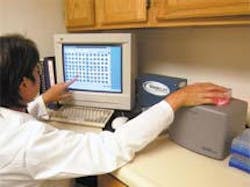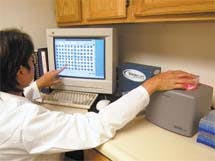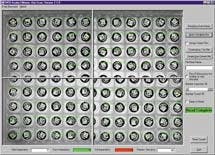Vial scan reader tracks DataMatrix code
During the past few years, biological-research processes such as the handling of test compounds dissolved in solution, the addition of biological reagents to form assays for screening in drug discovery, and genomics have moved from laboratory-based manual systems to automated systems to save money, improve accuracy, and shorten test time. They are now becoming fully integrated with other drug-discovery processes on an industrial scale.
Manufacturer of liquid-handling systems Matrix Technology (Hudson, NH) offers a range of products designed to automate medical pipetting procedures. One product, the PlateMate Plus, is a disposable tip or Teflon-coated steel needle pipette that uses deep or shallow well plates that can store from 96 to 384 different combinations of solutions. Because, in most applications, a large number of vials are used in liquid-handling processes, automated audit tracking is a major requirement of such systems.
In operation, each vial needs to be tracked as it is filled with reagent and moved to the next stage of the biomedical-analysis process. To do this, each vial is placed in a 12 x 8 cassette carrier and is individually stamped with a DataMatrix code so that computer system can perform audit tracking. Tracking every one of the 96 vials placed within a cassette carrier, however, requires that every vial must be scanned and imaged for data code and the data stored, all in less than 1 s. Unfortunately, no such data reader existed on the market. Accordingly, Matrix Technology called on RVSI Northeast Robotics (NER; Weare, NH) to build a customized and automated high-speed data reader for this purpose.
"In the design of the vial scan data reader," explains John Merva, RVSI general manager, "it was necessary to build a stand-alone reader and at the same time allow the reader to be reconfigured as an OEM product within vial-automation production equipment." High reading speed and reasonable cost were important requirements; the system also needed to be foolproof for operators not familiar with machine-vision applications.
To image the 5 x 4-in. area of the cassette holding the 96 vials, RVSI chose to light the vial cassette using a custom LED (light-emitting diode) fixture made up of a rectangular array of 642-nm LEDs from Toshiba America Information Systems (Irvine, CA) and angled upward under the platen of the vial scanner. "This dark-field approach enhances the contrast of surface features such as the DataMatrix code on each individual vial," says Merva.
To image the vial area in four sections, four STC-150/180 monochrome board cameras from Sensor Technologies America (Carrollton, TX) with 8.5-mm lenses from The Cosmicar Division of Pentax (Englewood, CO) were mounted to a metal plate located at the base of the unit. "Because the height of the unit needed to be kept to around 6 in.," says Merva, "these board cameras needed to be positioned at an angle at 5° to properly image the four quadrants of the bottom surface of the cassette." To capture the analog RS-170 output from each of the four cameras, RVSI built a custom cable to interface to the company's Visionscape Express machine-vision system.
The processor in the Visionscape Express system is supplied by RVSI Acuity CiMatrix (Nashua, NH). A Visionscape 1304 PCI board multiplexes and digitizes each RS-170 analog signal while acquiring an image every 33 ms. To image a complete vial cassette, four such images must be captured within 132 ms. Then, the images of the barcodes on the base surfaces of the 24 vials captured in each of the four sectors of the image are analyzed.
Says Merva, "RVSI used Visionscape 3.0 vision software to trigger the image capture and acquire and read the barcode on each vial. To present a complete image of the 8 x 12 array of 96 vials to the technician, a user interface was written in Microsoft Visual Basic. This user interface displays all 96 vials and states which vials have been read and which DataMatrix codes may be difficult or impossible to analyze. After the data codes are read, they can be exported from the Visionscape 3.0 software as a comma-delimited ASCII file for further analysis by database or spreadsheet-analysis packages.
The Vial Scan Reader will be sold by RVSI as a stand-alone product and as a branded third-party product by manufacturers such as Matrix Technology. At present, the reader can only be used with the company's Visionscape 1300 PCI board and software, but RVSI is prepared to offer the product as an OEM product to manufacturers wishing to add their own proprietary interfaces and DataMatrix interface software.


